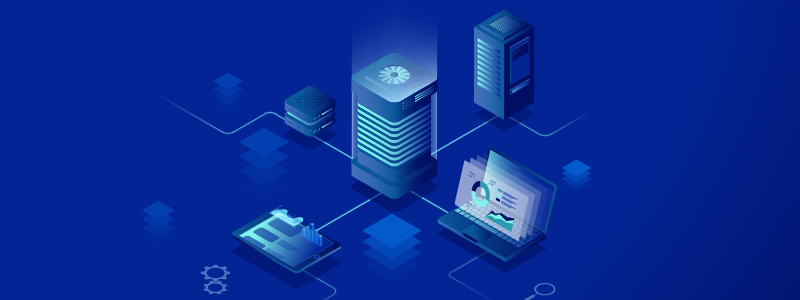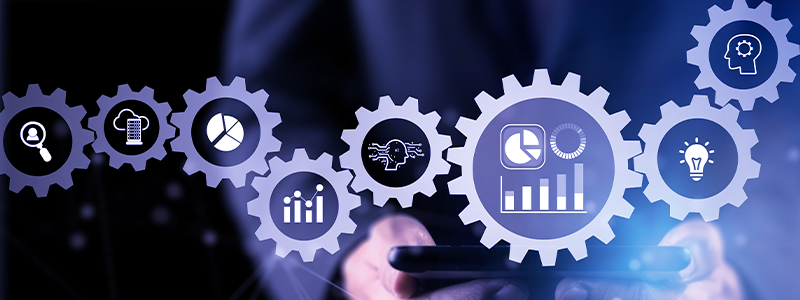
Are you trying to decide whether MySQL or SQL Server is the right database management system (DBMS) for your business? You’ve come to the right place. In this article, we’ll discuss two of the most popular DBMSs: MySQL vs. SQL Server. We’ll explain how they work and explore the differences between them, so you can confidently choose the best option for your data-centric needs.
We’ll also look at Astera Centerprise, a data integration solution that works with both MySQL and SQL Server databases. This way, no matter which DBMS you choose, you’ll have a powerful tool that can extract, transform, and load (ETL) data from MySQL or SQL Server into internal systems or other databases for performance optimization and analysis purposes.
MySQL Server is an open-source relational database management system (RDBMS) based on the Structured Query Language (SQL). It was designed for speed and scalability and supports a wide variety of applications, from web applications to data warehouses.
On the other hand, SQL Server is a Microsoft product that’s tailored to fit the Windows operating system. It’s slightly more robust than MySQL in terms of features, but it can also be more expensive due to licensing fees. Plus, since it’s built for Windows, you won’t get the same level of support that you would with MySQL.
What Is MySQL?
MySQL is an open-source relational database management system, owned by the Oracle Corporation. It is licensed under the GPL (General Public License) or a commercial license. MySQL is available for free and created in 1995 by a Swedish programmer, Michael “Monty” Widenius. It runs on many different platforms and is the default database for many popular web applications, such as WordPress and Joomla.
MySQL is written in C and C++, it uses Structured Query Language (SQL) to interact with databases and can handle large volumes of data. It’s versatile enough to be used with PHP, Java, and Python programming languages, among others. Furthermore, MySQL offers powerful control over data security by allowing users to access permissions at the table level—an important function in enterprise environments where multiple users need access to the same data.
Now that you know a bit about MySQL let’s look at SQL Server.
What Is SQL Server?
SQL Server is a relational database management system (RDBMS) developed by Microsoft, licensed under a proprietary license. It’s used by organizations to store information and manipulate data through queries. You can use a SQL server to add, delete or update records, or query the data stored inside it.
In terms of features, SQL Server offers:
- Advanced analytics powered by Machine Learning Services
- In-memory OLTP
- High availability and disaster recovery options
- Advanced Security features like Always Encrypted
- Data virtualization with Polybase
MySQL vs. SQL Server: Differences
MySQL and SQL Server are both relational database management systems (RDBMS) used to store and manage data, but there are some key differences between them:
- Operating Systems: MySQL is designed to run on multiple operating systems such as Windows, Linux, and macOS. SQL Server, on the other hand, is designed to run primarily on Windows but can also run on Linux.
- Scalability: MySQL is known for its scalability and can handle large amounts of data efficiently. SQL Server also offers scalability, but it is better suited for larger enterprises with more complex data requirements.
- Applicability: MySQL can be used to support web applications and mobile apps, while SQL Server tends to be better suited for large business applications like finance.
- Performance: MySQL is designed for high-performance data processing and can handle high traffic websites and applications with ease. SQL Server offers good performance but requires more system resources and hardware to achieve the same level of performance as MySQL.
- Security: Both offer strong security features, such as user authentication, access controls, and encryption. However, SQL Server offers more advanced security features, such as transparent data encryption and always-on availability groups.
- Cost: MySQL is open source and free to use, but the enterprise edition of MySQL and commercial support services can come with a cost. SQL Server, on the other hand, requires a license for each instance and can be more expensive.
- Storage Engines: MySQL offers a wider range of storage engines compared to SQL Server, which allows more flexibility when it comes to optimizing performance across different data workloads.
Overall, the choice between them largely depends on the specific needs of the organization, such as budget, data requirements, and IT infrastructure.
MySQL vs. SQL Server: Similarities

At a high-level, MySQL and SQL Server are quite similar. They both offer relational database management systems that operate as clients/servers and utilize Structured Query Language (SQL) to manipulate data. Both also offer the same basic features, including:
Also, both MySQL Server and SQL Server can be used for a variety of data sources, including enterprise applications, web-based applications, data warehouses, and embedded applications. Both platforms are fully compatible with many operating systems and languages—the main difference between them is in their design language.
MySQL uses the MySQL language, while SQL Server uses Transact-SQL (T-SQL). T-SQL has some additional features that are not present in the original MySQL language, such as stored procedures TRY/CATCH error handling, recursive queries with Common Table Expressions (CTE), and other functions that make it easier to write complex queries.
Stored procedures are pre-written sets of instructions that can be reused to perform a specific task. TRY/CATCH error handling allows developers to write code that can gracefully handle errors that may occur during the execution of a stored procedure or other queries. Recursive queries with CTE make it easier to write queries that need to repeatedly reference themselves or other tables.
In simpler terms, T-SQL has some additional tools and features that make it easier to write more complex and efficient queries compared to MySQL’s original language. These features allow developers to write reusable code, handle errors more gracefully, and write queries that reference themselves or other tables more easily.
How Does Astera Centerprise Use MySQL and SQL Server?
When deciding between MySQL and SQL Server, it ultimately depends on your specific technical needs and budget. However, Astera Centerprise provides support for both databases in one solution, It thus, makes it easier for you to integrate data without complex development efforts. You can directly connect to both MySQL and SQL Servers. Also, you can transfer data between them seamlessly using this powerful integration platform.
Moreover, Astera Centerprise offers a range of no-code capabilities. These include a drag-and-drop interface, pre-built connectors and transformations, and a visual designer. These allow users to create complex data integration workflows without writing any code.
With Astera Centerprise, users can easily configure and execute data integration tasks such as data mapping, data validation, and data transformation using a simple graphical user interface. This helps reduce development time and costs, and enables businesses to rapidly implement data integration solutions without a team of specialized developers.
Moreover, Astera Centerprise’s no-code capabilities also make it easier for non-technical users to work with data and automate their data integration processes. Thus, enabling businesses to be more agile and responsive to changing data needs.
So, how does Astera Centerprise use MySQL and SQL Server?
Data Migration
Astera Centerprise leverages both MySQL and SQL Server to support in-depth data migration projects. With its flexible connectors, it can access data stored on both databases and move it securely between them. Plus, Astera Centerprise can validate data stored in MySQL and SQL Server before migrating it. This guarantees that none of the information gets lost during transfer, allowing you to keep all your information safe during migration projects.
Streamline & Fortify Your Data Migration Processes with Astera
Seamlessly and securely move your valuable data with Astera. Simplify your migration process and unlock the power of automated data movement today!
Download Your Free 14-day Trial!
Data Integration
Additionally, Astera Centerprise can integrate data from both MySQL and MS SQL Server databases with ease! It works with different types of datasets such as structured or unstructured files (like CSV or Excel). It ensures that all your business operations are streamlined for improved productivity. Astera Centerprise also provides you with real-time insights into the status of your integration pipeliness so you’re always aware of what’s happening.
Distinguishing Features of Astera Centerprise for MySQL & SQL Server
When it comes to choosing a data integration solution for your MySQL or SQL Server databases, Astera Centerprise offers a host of features. These features empower you with total control over your data integration processes.
Let’s look at some of these distinguishing features:
Intuitive User Interface
Astera Centerprise offers an easy-to-navigate user interface that allows you to access all its features and functions quickly. You can easily set up jobs, automate tasks, design workflows, and monitor progress from one place.
Smooth Connectivity & Data Transfer
Centerprise ensures smooth connectivity and data transfer between MySQL and SQL server databases. Its smart ODBC driver enables high performance data transfer between both types of databases, allowing you to migrate large amounts of data within minutes.
Security & Reliability
Astera Centerprise ensures reliable backup and security for your data when performing complex tasks. These tasks include extracting, transforming, and loading (ETL) data into MySQL or SQL Server databases. It also offers powerful features such as job scheduling, logging, encryption, etc. These ensure maximum safety of your data throughout the entire process.
Flexible Processing Options
Centerprise allows you to customize processing options while transferring/loading data into MySQL/SQL Server databases. This includes sorting the source/target files and mapping source & target columns in any order. These are essential elements for successful transformation operations on both types of databases.
Conclusion
In conclusion, while MySQL and SQL Server are very similar databases, they do have a few critical differences. MySQL is well-suited for small to medium-sized applications, and it excels at web applications and cloud-hosted solutions. SQL Server is preferred to larger enterprise applications because of its robustness, scalability, and enhanced security options.
Utilizing Astera Centerprise for your data integration and transformation needs is an optimal way to make the most of both solutions. It bridges the gap between the two server types. Thereby, it helps organizations tap into the potential of the databases and maximize their data potential. Regardless of the server type you choose, Astera Centerprise will help you get the best out of the data.






